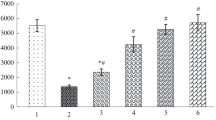Summary
The maximum activities of the enzymes of glycolysis of five tissues (cerebrum, heart, liver, kidney cortex and skeletal muscle) were examined in a hibernator, the Arctic ground squirrel, in both the summer-active and hibernating (winter) states. In addition, by observing through electrofocussing the appearance of variants of hepatic pyruvate kinase, an attempt was made to determine the time-course of preparation for hibernation. This process requires about 4 weeks, which is about the same as that for the preparation for emergence from hibernation. The separate tissues responded in individually characteristic fashions, although the enzymes from kidney cortex and liver tended to show a general increase and the enzymes from heart and brain showed a general decrease. The enzyme activities in skeletal muscle changed in seemingly disparate ways with some enzymes increasing in hibernation, while others decreased, and yet others remained unchanged. These results are discussed in the light of the hibernating habit of the mammal.
Similar content being viewed by others
References
Behrisch HW (1973) Molecular mechanisms of temperature adaptation in Arctic ecototherms and heterotherms. In: Wieser W (ed) Effects of temperature in ectothermic organisms. Springer, Berlin Heidelberg New York, pp 123–137
Behrisch HW (1974) Temperature and the regulation of enzyme activity in the hibernator. Isoenzymes of liver pyruvate kinase from the hibernating and non-hibernating Arctic ground squirrel. Can J Biochem 52:894–902
Behrisch HW (1978) Metabolic economy at the molecular level: the hibernator. In: Wang LC, Hudson J (eds) Strategies in cold: natural torpidity and thermogenesis. Academic Press, London New York, pp 461–497
Behrisch HW, Smullin DA, Morse GA (1981) Life at low and changing temperatures: molecular aspects. In: Musacchia XJ, Jansky L (eds) Survival in the cold: hibernation and other adaptation. Elsevier North-Holland, Amsterdam, pp 191–205
Bock PE, Gilbert HR, Frieden C (1975) Analysis of the cold lability of rabbit muscle phosphofructokinase. Biochem Biophys Res Commun 66:564–569
Burlington R, Klain GJ (1967) Gluconeogenesis during hibernation and arousal from hibernation. Comp Biochem Physiol 22:701–708
Deavers DR, Musacchia LK (1979) The function of glucocorticoids in thermogenesis. Fed Proc 38:2177–2181
Galster WA, Morrison PR (1975) Gluconeogenesis in Arctic ground squirrels between bouts of hibernation. Am J Physiol 228:325–330
Galster WA, Morrison PR (1976) Seasonal changes in body composition of the Arctic ground squirrel, Citellus undulatus. Can J Zool 54:74–78
Hand SC, Somero GN (1982) Urea and methylamine effects on rabbit muscle phosphofructokinase. Catalytic stability and aggregation state as a function of pH and temperature. J Biol Chem 257:734–741
Hock R (1960) Seasonal variation in physiologic functions in Arctic ground squirrels and brown bears. In: Lyman CP, Dawe AR (eds) Mammalian hibernation. Bull Mus Comp Zool, Harv Univ 124:155–171
Johnson CS, Deal W (1978) Low and high temperature asymmetric form of pig kidney and rabbit muscle phosphofructokinases and reversible, temperature-dependent transitions. Arch Biochem Biophys 190:560–570
Kayne FJ, Suelter CH (1965) Effects of temperature, substrate and activating cations on the conformations of pyruvate kinase in aqueous solution. J Am Chem Soc 87:897–900
Klain GJ (1976) Hepatic utilization of glutamate during the hibernation cycle. Life Sci 19:591–596
Krebs HA (1963) Renal gluconeogenesis. Adv Enzyme Regul 1:385–400
Lyman CP, Willis JS, Malan A, Wang LCH (1982) Hibernation and torpor in mammals and birds. Academic Press, London New York, 317 pp
Malan A (1980) Enzyme regulation metabolic rate and acid-base state in hibernation. In: Gilles R (ed) Animals and environmental fitness. Pergamon Press, London, pp 487–501
Morrison PK, Galster W (1975) Patterns of hibernation in the Arctic ground squirrel. Can J Zool 53:1345–1355
Newsholme EA, Start C (1973) Regulation in metabolism. Wiley, London, 349 pp
Orengo A, Patenia D (1976) Exploitable molecular mechanisms in hibernation. 1. Liver diphosphofructose phosphatase of the rat and hamster: a comparison. Comp Biochem Physiol 55B:283–291
Scrutton MB, Utter MF (1968) Regulation of glycolysis and gluconeogenesis in animal tissues. Ann Rev Biochem 37:249–302
Shaklee JB, Christiansen JA, Sidell BD, Prosser CL, Whitt GS (1977) Molecular aspects of temperature acclimation in fish: contributions of changes in enzymatic activities and isozyme patterns to metabolic reorganization in the green sunfish. J Exp Zool 201:1–20
Somero GN (1975) The role of isoenzymes in adaptation to varying temperatures. In: Markert C, Whitt C (eds) Isoenzymes II. Academic Press, London New York, pp 221–234
Tashima LS, Adelstein SJ, Lyman CP (1970) Radioglucose utilization by active, hibernating, and arousing ground squirrels. Am J Physiol 218:303–309
Twente JW, Twente JA (1967) Concentrations of D-glucose in blood of Citellus laterals after known intervals of hibernating periods. J Mammal 48:381–386
Weber G (1963) Study and evaluation of regulation of enzyme activity and synthesis in mammalian liver. Adv Enzyme Regul 1:1–35
Weber G, Banerjee G, Bronstein S (1961) Role of enzymes in homeostasis. 3. Selective induction of increases of liver enzymes involved in carbohydrate metabolism. J Biol Chem 236:3106–3111
Whitten BK, Klain GJ (1968) Protein metabolism in hepatic tissue of hibernating and arousing ground squirrels. Am J Physiol 214:1360–1362
Zar JH (1974) Biostatistical analysis. Prentice-Hall, Englewood Cliffs NJ, 620 pp
Zimny ML, Bourgeois C (1960) Histochemical localization of some enzymes in the kidney of a hibernator. J Cell Comp Physiol 56:93–97
Author information
Authors and Affiliations
Rights and permissions
About this article
Cite this article
Behrisch, H.W. Seasonal activity patterns of glycolytic enzymes in a hibernator, the Arctic ground squirrel Spermophilus parryi . Polar Biol 3, 55–61 (1984). https://doi.org/10.1007/BF00265568
Received:
Accepted:
Issue Date:
DOI: https://doi.org/10.1007/BF00265568



